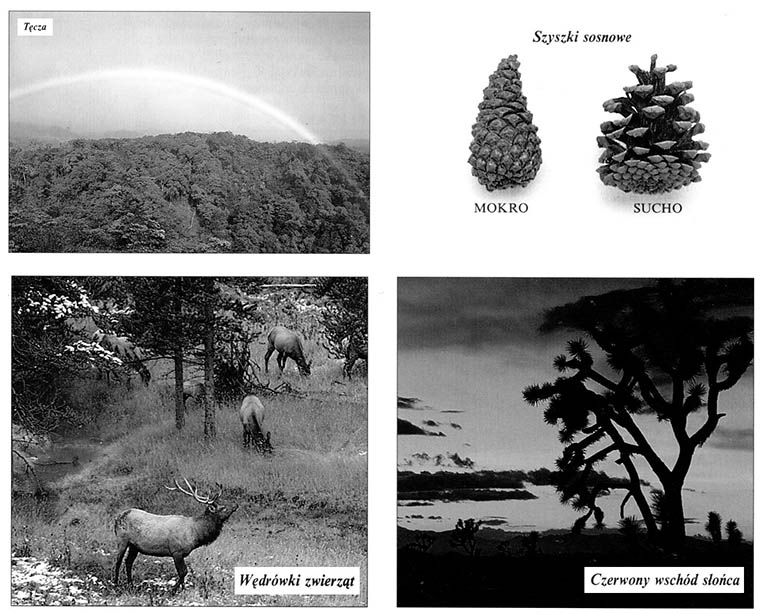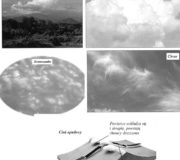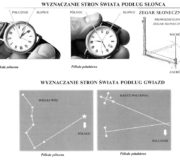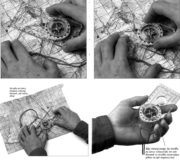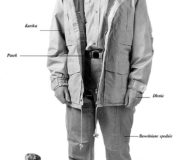Wiele mądrości ludowych dotyczących pogody wynika z wieloletnich obserwacji i ma racjonalne uzasadnienia, jak choćby te, które mówią o czerwonym wschodzie słońca czy księżycu w otoczce jako zapowiedziach zmiany pogody. Oprócz zjawisk na niebie i naturalnych fenomenów, takich jak tęcza, również obserwacja zachowań zwierząt może pomóc w prognozowaniu pogody.
Tęcza
Powstaje na skutek przechodzenia promieni słonecznych przez drobne kropelki wody znajdujące się w powietrzu, zwykle podczas lub bezpośrednio po deszczu. Kropelki wody przypominają maleńkie pryzmaty, rozszczepiają białe światło słoneczne na jego składowe barwy. Tęcza zapowiada zwykle ładną pogodę, zwłaszcza jeśli pokazuje się po południu.
Wędrówki zwierząt
Wiele zwierząt potrafi wyczuć ruchy powietrza i zmiany ciśnienia atmosferycznego, które zapowiadają zmianę pogody. Jeśli się zbliża burza lub śnieżyca, wiele zwierząt stadnych żyjących w górach schodzi niżej, w bezpieczniejsze doliny.
Czerwony wschód słońca
Czerwone zabarwienie nieba o brzasku oznacza, że w powietrzu znajduje się dużo wilgoci, ponieważ wschodzące słońce odbija się od chmur.
Załamanie pogody może zapowiadać zmiana kierunku i siły wiatru, czy pojawienie się na niebie nowego rodzaju chmur. Przeważające wiatry zwykle przynoszą pogodę charakterystyczną dla danego terenu w określonej porze roku. Suchy, silny wiatr zmieniający kierunek lub słabnący zapowiada zwykle zmianę pogody. Poranna rosa lub mgła pozwala się spodziewać stałej pogody, ale jeśli wieje wiatr i przypędza na wzgórza mgłę, może to przynieść deszcz. Czyste niebo o zmroku zapowiada noc pogodną, ale i chłodną, gdyż nie będzie chmur, które powstrzymują ucieczkę ciepła. Przed deszczem zmiana ciśnienia atmosferycznego powoduje bóle u osób cierpiących na reumatyzm, sprawia, że rośliny rozszerzają swe pory, dlatego silniej pachną, oraz wywołuje puchnięcie przedmiotów wykonanych z drewna.
Szyszki sosnowe
Szyszki sosnowe reagują na wilgoć. Jeśli powietrze jest suche, łuski wysychają i odginają się. Szyszka otwiera się. Tuż przed opadem łuski wilgotnieją i zamykają się z powrotem, a szyszka nabiera poprzedniego wyglądu.
Skała Beauforta
Załamania pogody zapowiadają z reguły zmiany kierunku i siły wiatru. Skala Beauforta to porównawcza skala siły wiatru. Silę wiatru ocenia się na podstawie objawów obserwowanych w terenie oraz stanu morza. Umownie podzielona jest na 12 stopni – od ciszy po huragan.
| SKALA BEAUFORTA | |||
| Stopnie | Nazwa wiatru | Prędkość (m/s) | Objawy |
| 0 | Cisza | 0-0,2 | Dym wznosi się pionowo |
| 1 | Powiew | 0,3-1,5 | Dym wznosi się pochyło, wskazując kierunek wiatru |
| 2 | Słaby wiatr | 1,6-3,3 | Wiatr odczuwa się na twarzy |
| 3 | Łagodny wiatr | 3,4-5,4 | Wiatr porusza liśćmi drzew, rozwija flagi |
| 4 | Umiarkowany wiatr | 5,5-7,9 | Wiatr porusza gałązkami drzew, unosi kurz z ziemi |
| 5 | Dość silny wiatr | 8-10,7 | Wiatr rusza gałęzie |
| 6 | Silny wiatr | 10,8-13,8 | Wiatr rusza konary, trudno utrzymać parasol |
| 7 | Bardzo silny wiatr | 13,9-17,1 | Wiatr rusza cienkie pnie, utrudnia marsz |
| 8 | Wicher, gwałtowny wiatr | 17,2-20,7 | Trudno iść pod wiatr, chwieją się pnie |
| 9 | Wiatr sztormowy, wichura | 20,8-24,4 | Wiatr unosi mniejsze przedmioty, zrywa dachówki |
| 10 | Sztorm, silna wichura | 24,5-28,4 | Wiatr łamie gałęzie i konary |
| 11 | Silny sztorm, gwałtowna wichura | 28,5-32,6 | Walą się drzewa |
| 12 | Huragan | ponad 32,7 | Drzewa wyrywane z korzeniami, zrywane dachy, zwalone budynki |
